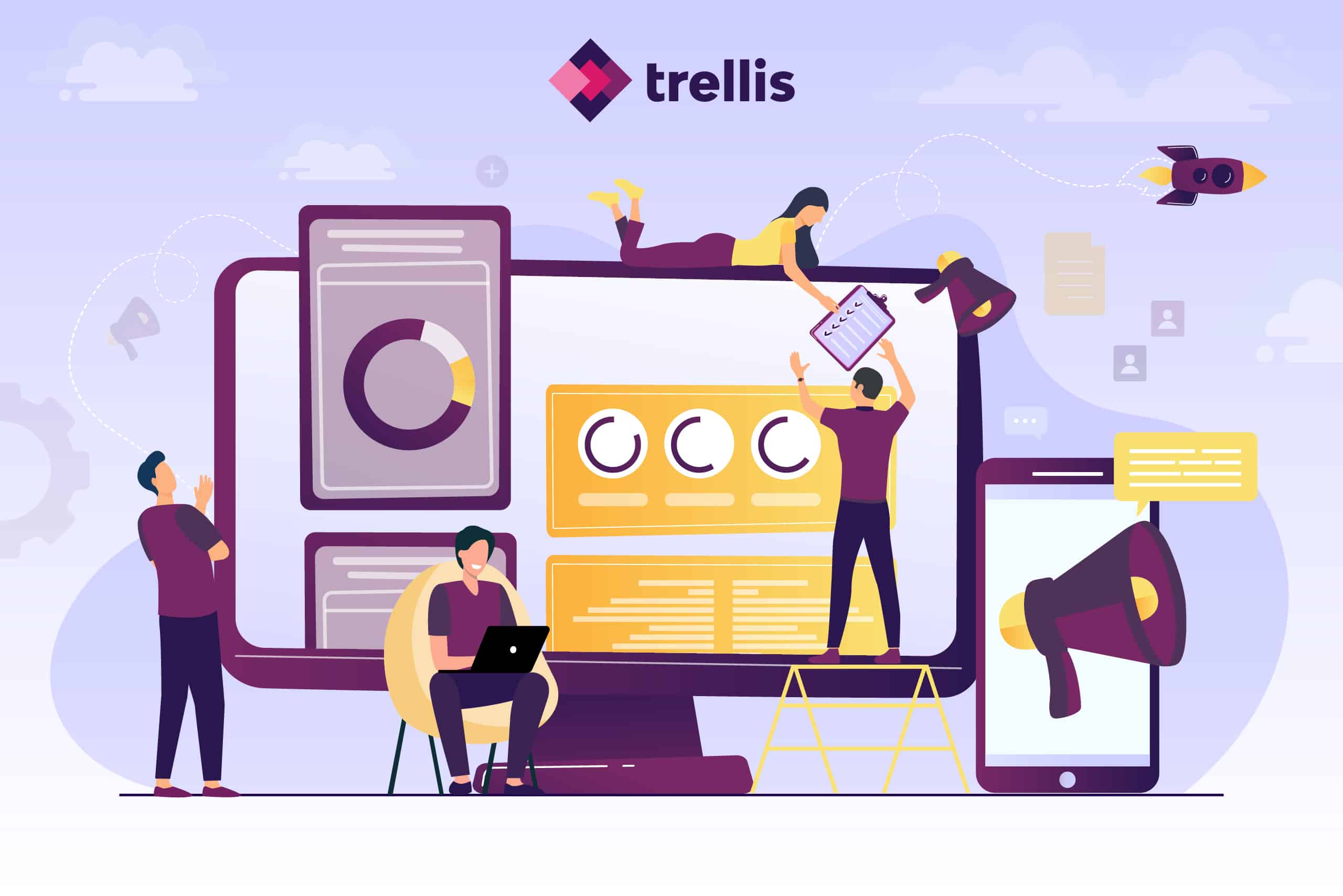The Amazon Demand-side Platform (DSP) is a programmatic advertising tool that helps sellers buy digital advertising space in real-time across a variety of platforms. It allows third-party merchants to target relevant audiences efficiently using data-driven strategies.
Whether you’re just getting started with DSP campaigns or looking for new ways to improve your advertising cost of sales (ACoS), this article will help you understand what Amazon DSP is and how to use it to promote products, run campaigns, and elevate your media buying strategy.
Sponsored ads or DSP? Why not both? Trellis is the self-driving software solution that helps you optimize every campaign. Learn how it works with a free demo.
Benefits of the Amazon Demand Side Platform
In 2018, Amazon Advertising underwent a major rebranding in an effort to simplify the seller experience. As part of this initiative, the Amazon Advertising Platform was renamed the Amazon Advertising Demand Side Platform (DSP).
Since then, the mega marketplace has added a host of new features and functionalities for Amazon sellers, including advanced machine learning to connect with relevant shoppers no matter where they are online.
1. Prime Audience Building Opportunities
There’s a reason major brands like Sony and Nestlé use the Amazon DSP. With the ability to build custom audiences using vast amounts of Amazon-owned first-party (1P) data, the DSP gives you access to valuable customer targeting data you can’t get anywhere else.
You can access multiple 1P audience segments via Amazon Audiences, including:
- Behavioral targeting
- Contextual targeting
- Lifestyle targeting
- Remarketing
- Audience lookalike
Whether your focus is top-of-funnel brand awareness or bottom-of-funnel remarketing, Amazon DSP ads can help you get more out of your ad budget. The Amazon DSP constantly updates your audiences and automatically purchases ads on your behalf, helping merchants of all sizes execute the same large-scale programmatic advertising strategies employed by larger brands.
By gaining access to relevant, real-time data and established behavioral histories only available via the DSP, you can boost the potential of every ad, on and off Amazon, by automatically making ad placement decisions that are grounded in deep audience data.
2. Quality Ads and Engagement
DPS ads can be placed anywhere online and across any device, giving you a wealth of options when it comes to engaging users. The Amazon DSP currently offers the following ad types:
- Display ads
- Video ads
- Audio ads
You can choose to use custom ads or use Amazon eCommerce creative templates to automatically add the right images and elements to your product detail page.
If you’re looking for campaign ideas, Amazon shares several Amazon DSP examples on its resource page, including case studies from brands like Cheetos, Mattel and Chevrolet.
3. Scale Your Pay-Per-Click (PPC)
The Amazon DSP was built for advertisers who need to buy ads at scale, making it a great choice for brands with an omnichannel strategy, large product catalog, and/or agencies operating on behalf of a range of brands and sellers.
No matter how your business is structured, before getting started on DSP, it’s a good idea to make sure your:
- PPC is running smoothly and efficiently
- Listings are generating a steady stream of traffic
- Products have at least 15 reviews with an 3.5 average star rating
With the right foundations in place, the Amazon DSP can offer a seamless route toward greater return on ad spend (RoAS).
Self-Service vs. Managed-Service DSP
There are two ways to start using the Amazon Advertising DSP: self-service and managed-service. Let’s take a closer look at each so you can determine which approach is right for you.
Self-Service DSP
This option is open to any advertiser and is perfect for those who love to get deep into the weeds and manually fine tune audience demographics and campaigns for maximum performance. But keep in mind, programmatic advertising moves quickly. Make sure you know your data and have a process in place for tracking your core metrics in real-time.
Managed-Service DSP
With a minimum spend of $50,000 USD, managed-service DSP automates much of the ad campaign management process for you, helping you take advantage of the platform’s ad inventory without the manual time investment. It also includes integrated consultative services that take the optimization off your shoulders by using your data and audience insights to ensure any updates made to your ad campaigns are thoughtful and effective.
Is DSP worth it? Dive into the estimated costs of an Amazon DSP campaign, plus how to know if it’s the right choice for your business.
6 Ad Targeting Options in the Amazon DSP
There’s a total of six targeting options for those who choose to utilize the Amazon Advertising DSP, regardless of whether they opt for the self-service or managed-service format. Let’s take a closer look.
1. Behavioral Segments
These are audiences with predictable behaviors. Targeting usually focuses on demonstrated buying intent and recent search habits. A great example of this type of segment is a user who is clearly looking for a smartphone, researching models to the point that it’s clear what operating system and feature set they may be interested in.
2. Lifestyle Segments
Are you noticing users who are clearly passionate about a certain hobby or lifestyle choice? Those fitness fanatics, PC builders and dedicated pet owners tend to exhibit a sustained interest in related products and search terms. Your ads can be targeted to broadly appeal to a certain lifestyle group, advertising products that can help them get even more out of their favorite activities and interests.
3. Contextual Segments
With contextual segments, ads treat target audiences like moving targets, updating parameters as their interests and search histories change. Ads must be relevant to their shopping experience in the here and now, meaning that you’ll also need access to real-time data to take advantage of this segment.
4. Remarketing Segments
Know of a user who has a history of searching for and viewing your products, perhaps leaving a few items in the cart before deciding on something else? Or maybe you’ve accumulated a conversion or two from them making purchases in your listings. Either way, you want to remain a relevant option to them. Remarketing can help with that by optimizing existing ads to reconnect with these same users. For instance, if someone recently purchased a desktop computer, they might also be interested in a mouse or keyboard to go with their purchase.
5. Audience Lookalike Segments
Simply put, individuals in this audience segment share similar search, browsing, and shopping histories. Their behaviors may even match those of your most recent shoppers, making it easier to target a larger pool of prospective leads.
6. Advertiser Audience Segments
Finally, this segment can include any information your company already has. This can include customer relationship management (CRM) databases, customer feedback, and other areas where raw user data can help increase your targeting and relevance.
Elevate Your Amazon DSP Advertising with Trellis
In an environment where ad costs and bottom line pressure are rising, combining search and display advertising is a great way to futureproof your strategy. With the Amazon DSP, you can make sure you leave no click or conversion behind.
Trellis helps automate your ad strategy by making necessary changes in the background, with as little as a single click. No matter how many ads you have running or where they’re placed, our powerful advertising platform can help you secure the best bidding rates on keywords, driving down ACoS while increasing your profitability.
Optimize multiple campaigns with one click. Trellis is an eCommerce merchandising and advertising software that provides brands with powerful Amazon PPC automation tools to scale revenue growth. Book your free personalized demo to learn more.
Amazon Demand Side Platform: FAQs
Ready to get started? Here are some of the top FAQs about the Amazon Demand Side Platform.
What’s the Difference Between Amazon DSP and Amazon Sponsored Display?
Amazon DSP is a robust platform offering advanced targeting, broader inventory access, various ad formats, and flexible campaign objectives, both on and off Amazon. Amazon Sponsored Display, on the other hand, is more focused on targeting customers within Amazon’s ecosystem with primarily display ad formats and is often used for simpler retargeting campaigns or promoting products within the Amazon marketplace.
What Is a “Programmatic” Ad?
A “programmatic” ad refers to the automated process of buying and selling digital advertising space in real-time through the use of software and algorithms. The programmatic advertising made possible by Amazon DSP enables advertisers to target specific audiences, optimize campaign performance, and deliver ads across various digital channels efficiently by using anonymized first-party data.
What Is Amazon Attribution?
Amazon Attribution is a free advertising and analytics measurement solution provided by Amazon. Amazon DSP utilizes a 14-day, last-touch attribution model, although Amazon Marketing Cloud does offer the potential to use more advanced attribution settings.
How Much Does It Cost to Get Started on Amazon DSP?
To get started on Amazon DSP, you can opt for the self-service option without management fees or the managed-service option with a minimum spend requirement of $50,000 USD.



